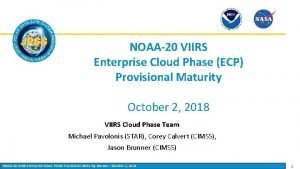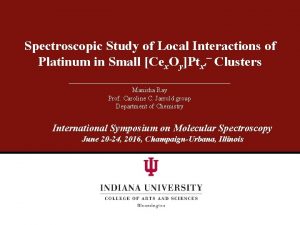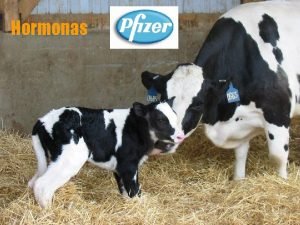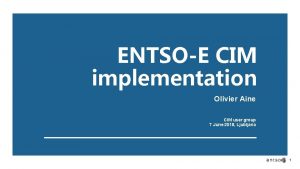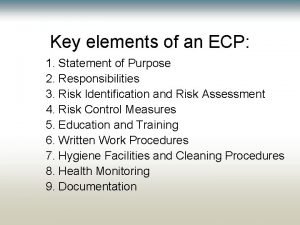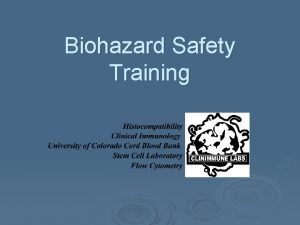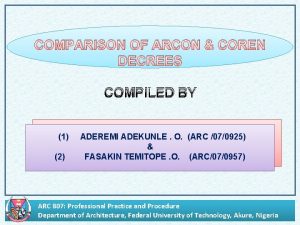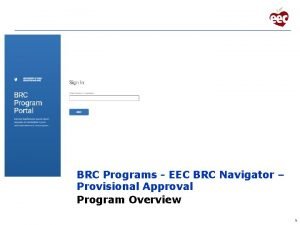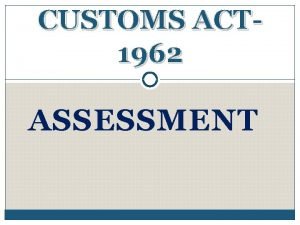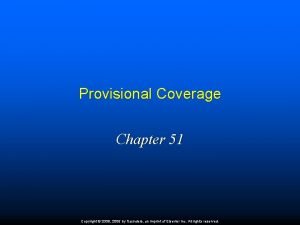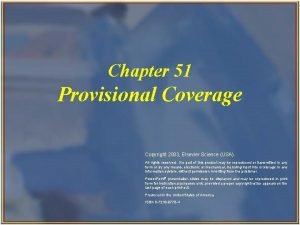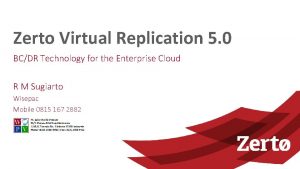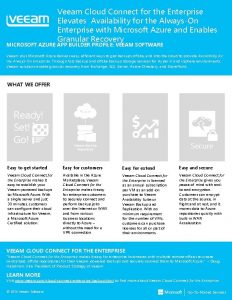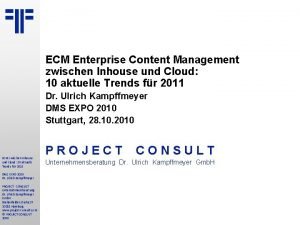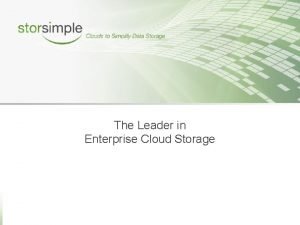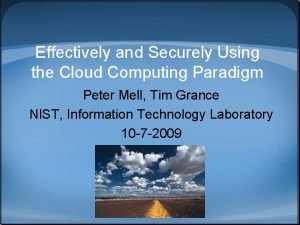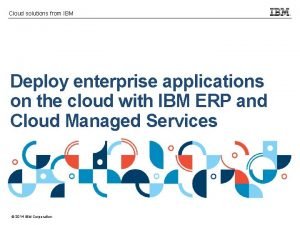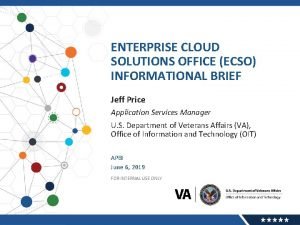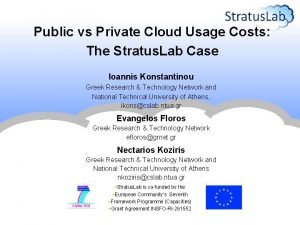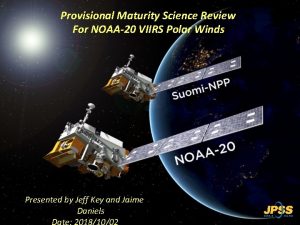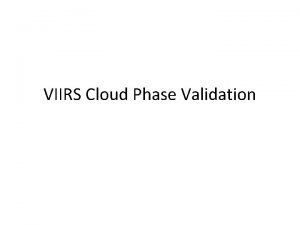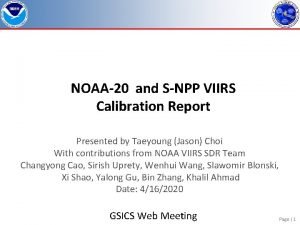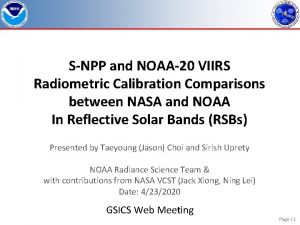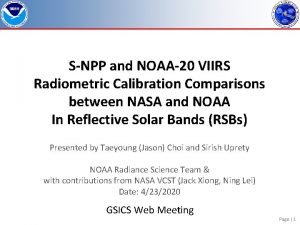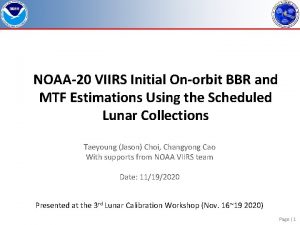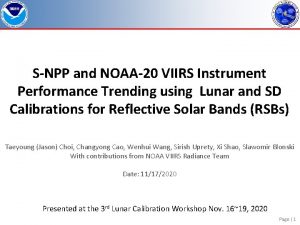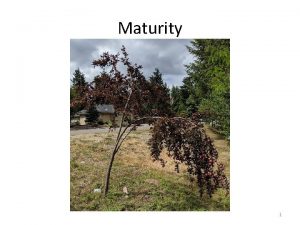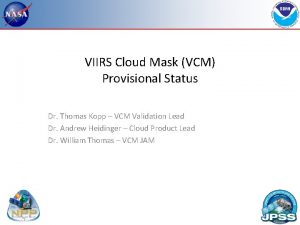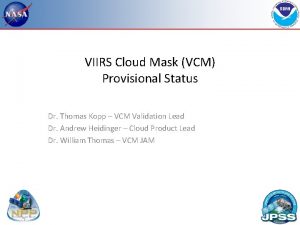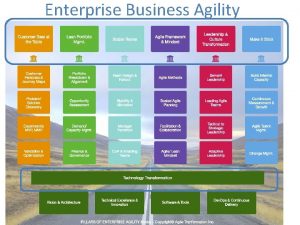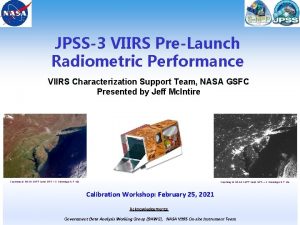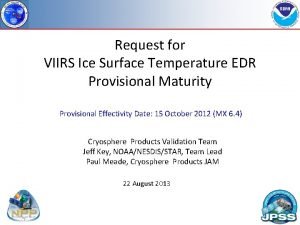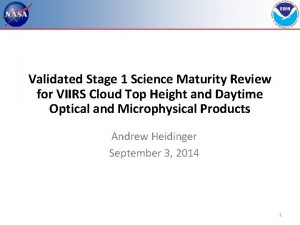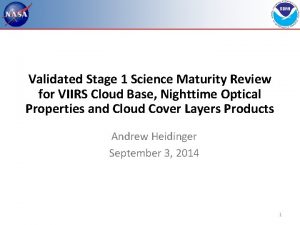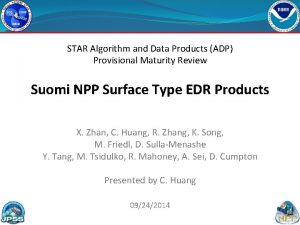NOAA20 VIIRS Enterprise Cloud Phase ECP Provisional Maturity










































- Slides: 42

NOAA-20 VIIRS Enterprise Cloud Phase (ECP) Provisional Maturity October 2, 2018 VIIRS Cloud Phase Team Michael Pavolonis (STAR), Corey Calvert (CIMSS), Jason Brunner (CIMSS) NOAA-20 VIIRS Enterprise Cloud Phase Provisional Maturity Review – October 2, 2018 1

Outline • • Description Status in NDE SDR Issues Evaluation Provisional Maturity Conclusions Path Forward to Full Validation Maturity Future Plans NOAA-20 VIIRS Enterprise Cloud Phase Provisional Maturity Review – October 2, 2018 2

STAR ECP Cal/Val Team Name Organization Major Task Michael Pavolonis NESDIS/STAR Cloud Phase PI Corey Calvert CIMSS Algorithm development and validation Jason Brunner CIMSS Algorithm development and validation William Straka CIMSS ASSISTT integration Shuang Qiu OSPO Product Area Lead NOAA-20 VIIRS Enterprise Cloud Phase Provisional Maturity Review – October 2, 2018 3

Enterprise Cloud Phase Review NOAA-20 VIIRS Enterprise Cloud Phase Provisional Maturity Review – October 2, 2018 4

Enterprise Cloud Phase • Supports many sensors and its part of the NOAA Enterprise Algorithm Suite. • It uses NASA CALIPSO data for its training. • The primary output is the cloud phase (integer values 0 – 5). • Enterprise phase is determined using multiple threshold-based radiometric tests. • The demand for one algorithm to serve many sensors drove the ECM development. NOAA-20 VIIRS Enterprise Cloud Phase Provisional Maturity Review – October 2, 2018 5

How to Use the Enterprise Cloud Phase • The fundamental output of the ECP is the cloud phase. • The cloud phase output corresponds to the following cloud phase categories • 0 – Clear • 1 – Liquid water phase • 2 – Supercooled water phase • 3 – Mixed phase • 4 – Ice phase • 5 – Unknown NOAA-20 VIIRS Enterprise Cloud Phase Provisional Maturity Review – October 2, 2018 6

ECP Heritage • ECP has run for years on GOES in OSPO and other sensors in STAR. NOAA-20 VIIRS Enterprise Cloud Phase Provisional Maturity Review – October 2, 2018 • Here is an example of the NOAA Enterprise Cloud Phase applied to GOES-16. 7

ECP Channels ● ECP uses the following channels ○ M 14 ○ M 15 ○ M 16 NOAA-20 VIIRS Enterprise Cloud Phase Provisional Maturity Review – October 2, 2018 8

Users of the ECP ● Enterprise Cloud Algorithms. ● VIIRS Polar Winds. ● Potentially External VCM Users (we know of none). NOAA-20 VIIRS Enterprise Cloud Phase Provisional Maturity Review – October 2, 2018 9

Enterprise Cloud Phase NDE Status NOAA-20 VIIRS Enterprise Cloud Phase Provisional Maturity Review – October 2, 2018 10

NDE/STAR VIIRS ECP Production Status Algorithm February 2018 DAP w/o April patch (missing granules) August 2017 Science Code delivery (v 1 r 2) August 2018 DAP Suomi NPP NOAA-20 NDE Currently in Operations since 1200 UTC on 13 August 2018 Currently in I&T since 28 March, 2018 STAR Systematic production since June, 2018 February 2018 Science Code delivery (v 2 r 0) NDE I&T on as of 28 September, 2018 Delivery and development in progress Delivery schedule provided by ASSISTT Jan/Feb 2019 DAP August 2018 Science Code delivery (v 2 r 1) NOAA-20 VIIRS Enterprise Cloud Phase Provisional Maturity Review – October 2, 2018 11

SDR Issues NOAA-20 VIIRS Enterprise Cloud Phase Provisional Maturity Review – October 2, 2018 12

SDR Issues • No known issues. NOAA-20 VIIRS Enterprise Cloud Phase Provisional Maturity Review – October 2, 2018 13

Evaluation of the NDE ECP NOAA-20 VIIRS Enterprise Cloud Phase Provisional Maturity Review – October 2, 2018 14

Requirements ● Measurement accuracy of 80% correct classification for Cloud Phase for clouds with an optical depth >1. 0 NOAA-20 VIIRS Enterprise Cloud Phase Provisional Maturity Review – October 2, 2018 15

JPSS Data Products Maturity Definition JPSS/GOES-R Data Product Validation Maturity Stages – COMMON DEFINITIONS (Nominal Mission) 1. Beta o Product is minimally validated, and may still contain significant identified and unidentified errors. o Information/data from validation efforts can be used to make initial qualitative or very limited quantitative assessments regarding product fitness-for-purpose. o Documentation of product performance and identified product performance anomalies, including recommended remediation strategies, exists. 2. Provisional o Product performance has been demonstrated through analysis of a large, but still limited (i. e. , not necessarily globally or seasonally representative) number of independent measurements obtained from selected locations, time periods, or field campaign efforts. o Product analyses are sufficient for qualitative, and limited quantitative, determination of product fitness-for-purpose. o Documentation of product performance, testing involving product fixes, identified product performance anomalies, including recommended remediation strategies, exists. o Product is recommended for potential operational use (user decision) and in scientific publications after consulting product status documents. 3. Validated o Product performance has been demonstrated over a large and wide range of representative conditions (i. e. , global, seasonal). o Comprehensive documentation of product performance exists that includes all known product anomalies and their recommended remediation strategies for a full range of retrieval conditions and severity level. o Product analyses are sufficient for full qualitative and quantitative determination of product fitness-for-purpose. o Product is ready for operational use based on documented validation findings and user feedback. o Product validation, quality assurance, and algorithm stewardship continue through the lifetime of the instrument. NOAA-20 VIIRS Enterprise Cloud Phase Provisional Maturity Review – October 2, 2018 16

Evaluation Methodology We have chosen independent sources of cloudiness that provide qualitative and quantitative analysis of the performance over a short time. Our Specific Evaluation Methodology applied here: 1. Validation against NASA CALIPSO/CALIOP 1. Comparison NDE ECP to GOES-16 phase from the ground system 1. Visual inspection of NDE ECP with ECP using S-NPP NOAA-20 VIIRS Enterprise Cloud Phase Provisional Maturity Review – October 2, 2018 17

Data Used in this Analysis • NOAA-20 NDE v 1 r 2 from June 3 and September 12, 2018 for GOES-16 and S-NPP Comparisons. • GOES-16 ground system output from June 3, 2018. • S-NPP NDE v 1 r 2 from September 12, 2018. • 3 days for CALIPSO Comparison: June 19, July 5 and Sept. 4, 2018. NOAA-20 VIIRS Enterprise Cloud Phase Provisional Maturity Review – October 2, 2018 18

Comparison to CALIPSO/CALIOP NOAA-20 VIIRS Enterprise Cloud Phase Provisional Maturity Review – October 2, 2018 19

CALIPSO vs NOAA-20 Comparison Description • CALIOP is a lidar, with depolarization, on board the CALIPSO satellite in the NASA A-Train. • The CALIOP 1 and 5 km vertical feature mask products are merged to derive the cloud phase of the highest cloud layer with CALIOP 532 nm optical depth > 0. 01 • 3 days of CALIOP and NOAA-20 Matchup data are used • ? ? ? (these were for GOES-16) Filters applied to NOAA 20: – Scan time difference ± 7. 5 minutes, – Sensor Zenith Angle < 70. 0 – NOAA-20 and CALIOP agree that a cloud is present • Validation analysis is a function of the CALIOP 532 nm cloud optical depth NOAA-20 VIIRS Enterprise Cloud Phase Provisional Maturity Review – October 2, 2018 20

CALIPSO vs NOAA-20 Validation The NOAA-20 cloud top phase product meets the accuracy specification for optical depths < 1. 0, but is slightly below for optical depths >1. 0. Adding additional CALIOP match-ups has little impact on bulk stats (law of large numbers). Requirement NOAA-20 VIIRS Enterprise Cloud Phase Provisional Maturity Review – October 2, 2018 21

NOAA-20 Liquid Phase Validation NOAA-20 VIIRS Enterprise Cloud Phase Provisional Maturity Review – October 2, 2018 22

NOAA-20 Supercooled Phase Validation NOAA-20 VIIRS Enterprise Cloud Phase Provisional Maturity Review – October 2, 2018 23

NOAA-20 Mixed Phase Validation NOAA-20 VIIRS Enterprise Cloud Phase Provisional Maturity Review – October 2, 2018 24

NOAA-20 Ice Phase Validation NOAA-20 VIIRS Enterprise Cloud Phase Provisional Maturity Review – October 2, 2018 25

NOAA-20 Single Layer Ice Phase Validation NOAA-20 VIIRS Enterprise Cloud Phase Provisional Maturity Review – October 2, 2018 26

NOAA-20 Multi-Layer Ice Phase Validation NOAA-20 VIIRS Enterprise Cloud Phase Provisional Maturity Review – October 2, 2018 27

Conclusions from CALIPSO Comparisons • The ECP NDE meets the 80% accuracy requirement for clouds with optical depths <1. 0, but is slightly below the required specification for clouds with optical depths >1. 0. • Overall, ECP NDE shows a good performance, even though it is slightly below the required specifications. • Updated threshold training specific to NOAA-20 will likely improve the performance NOAA-20 VIIRS Enterprise Cloud Phase Provisional Maturity Review – October 2, 2018 28

Comparison with GOES-16 NOAA-20 VIIRS Enterprise Cloud Phase Provisional Maturity Review – October 2, 2018 29

NOAA-20 vs GOES-16 Comparison • • • NOAA-20 phase was co-located with GOES-16 phase for June 3, 2018. GOES-16 vs. NOAA-20 Cloud Phase Confusion Matrix GOES-16 Ice 8, 734, 491 2, 031, 734 5, 792, 521 64, 076, 122 Co-located pixels where both NOAA-20 and GOES-16 indicated cloudy pixels and the GOES-16 viewing angle was <60 deg were used GOES-16 Mixed 473, 172 1, 188, 828 1, 723, 801 501, 344 GOES-16 SC 1, 367, 316 5, 152, 019 843, 511 291, 588 GOES-16 Liquid 53, 500, 024 2, 019, 870 705, 014 4, 357, 167 NOAA-20 Liquid NOAA-20 SC NOAA-20 Mixed NOAA-20 Ice 152, 758, 528 pixels were used in this analysis NOAA-20 VIIRS Enterprise Cloud Phase Provisional Maturity Review – October 2, 2018 30

NOAA-20 vs GOES-16 Comparison • Red circle highlights area where NOAA-20 phase returns a higher number of mixed phase pixels where GOES-16 phase indicates ice phase • This specific difference in phase classification between GOES-16 and NOAA-20 shows up in the confusion matrix and appears to occur most often near cloud edges NOAA-20 VIIRS Enterprise Cloud Phase Provisional Maturity Review – October 2, 2018 31

NOAA-20 vs GOES-16 Comparison • The lack of ‘clear’ pixels in the NOAA-20 cloud phase was the result of a threshold issue in the ECM when determining the 4 -level cloud mask (this issue has since been resolved) • The ECM team recommends a threshold-based approach using the cloud mask probability product over the 4 -level cloud mask • The ECP algorithm should be updated to utilize the ECM as recommended NOAA-20 VIIRS Enterprise Cloud Phase Provisional Maturity Review – October 2, 2018 32

Conclusions from GOES-16 Comparisons • Overall the NOAA-20 ECP compares well to GOES-16 • NOAA-20 ECP returns a higher amount of mixed phase pixels when GOES-16 detects ice, mostly near cloud edges • Bug in the NOAA-20 ECM 4 -level product was identified and has been corrected (June 2018 DAP) NOAA-20 VIIRS Enterprise Cloud Phase Provisional Maturity Review – October 2, 2018 33

S-NPP and NOAA-20 Continuity NOAA-20 VIIRS Enterprise Cloud Phase Provisional Maturity Review – October 2, 2018 34

S-NPP and NOAA-20 Continuity • Animation composed of sequential cloud phase images from NOAA-20 and S-NPP for September 12, 2018 • There are still a large number of NOAA-20 granule outages • Other than the granule outages there do not appear to be any major artifacts between the two phase products NOAA-20 VIIRS Enterprise Cloud Phase Provisional Maturity Review – October 2, 2018 35

Investigation of Downstream Issues NOAA-20 VIIRS Enterprise Cloud Phase Provisional Maturity Review – October 2, 2018 36

Investigation of Downstream Issues • The overall Enterprise Cloud Phase Algorithm works well • However, when the cloud phase is wrong, it has a large impact on the cloud height retrieval. • There are 2 potential issues the phase team may want to track 1. Ice cloud phase on the edges of water cloud 2. Determination of ice phase when NIR imagery indicates otherwise • Previously published research has shown that these issues can be mostly mitigated by incorporating near-infrared measurements. The use of nearinfrared measurements is complicated by highly variable surface reflectance and sun geometry. Thus, the mitigation strategy adds complexity to the algorithm. NOAA-20 VIIRS Enterprise Cloud Phase Provisional Maturity Review – October 2, 2018 37

Provisional Maturity Conclusions • There are still issues with the NDE ECP v 1 r 2 on NOAA-20. • The accuracy requirement of 80% accuracy of cloud classification for clouds with optical depths >1. 0 has not yet been achieved • The NDE ECP accuracy for clouds with optical depth >1. 0 was 78% • The NDE ECP accuracy for clouds with optical depth >2. 0 was 74% • NOAA-20 specific threshold tuning should improve performance • Incorporating near-IR channels may also help, but the additional complexities this would create requires further guidance on whether to proceed • The Cloud Team recommends Beta Maturity at this time. NOAA-20 VIIRS Enterprise Cloud Phase Provisional Maturity Review – October 2, 2018 38

Pathway to Full Validation • We expect to apply the same activities to be conducted for Full Validation Maturity: – We are gathering an archive of golden days where we save SDRs and EDRs over a long time period. This collection is underway. – We will work with the other teams this winter on application-specific analysis. – We will take advantage of opportunities for threshold adjustments. NOAA-20 VIIRS Enterprise Cloud Phase Provisional Maturity Review – October 2, 2018 39

Risks for Full Validation Currently outstanding issues, unless fixed by handover, may prevent declaration of Full Validation Maturity: – NDE processing issues (Moderate) • – Accuracy of <80% correct classification for Cloud Phase for clouds with an optical depth >1. 0 (Moderate) • • – Missing granules in NDE processing – Addressed in August 2018 delivery (v 2 r 0) – Fix currently running in I&T string (as of 28 Sept 2019). Expected operations in late 2018 Update NOAA-20 specific phase test thresholds to improve performance Update how the ECM is utilized in the ECP by using the cloud probabilities rather than the 4 -level masks NOAA-20 specific ECP Threshold Updates • Training requires data from all seasons. Expected delivery by April 2019 DAP NOAA-20 VIIRS Enterprise Cloud Phase Provisional Maturity Review – October 2, 2018 40

Future Plans of ECP • Update the use of the 4 -level cloud mask to a threshold-based cloud mask using the cloud probabilities • Use large NOAA-20 dataset encompassing all seasons to fine tune the cloud phase thresholds • Determine the benefit of adding near-IR channels to improve algorithm performance and minimize issues created in downstream algorithms NOAA-20 VIIRS Enterprise Cloud Phase Provisional Maturity Review – October 2, 2018 41

Backup Material NOAA-20 VIIRS Enterprise Cloud Phase Provisional Maturity Review – October 2, 2018 42
 Ecp cloud
Ecp cloud Importance of maturity indices
Importance of maturity indices سيكساوي
سيكساوي Ovalyse
Ovalyse Ecp
Ecp Cgm ecp
Cgm ecp Ecp
Ecp Ecp
Ecp Ecp 1
Ecp 1 Ecp
Ecp Enterprise architecture maturity assessment
Enterprise architecture maturity assessment Inverted provisional stenting
Inverted provisional stenting Arcon provisional registration
Arcon provisional registration Nurse verification bccnp
Nurse verification bccnp Brc program portal
Brc program portal Customs assessment
Customs assessment Chapter 51 provisional coverage fill in the blank
Chapter 51 provisional coverage fill in the blank What is the purpose of provisional coverage
What is the purpose of provisional coverage Anotimpul iarna ppt
Anotimpul iarna ppt Mobile phase and stationary phase
Mobile phase and stationary phase Which detector used in hplc
Which detector used in hplc Hplc definition
Hplc definition Phase to phase voltage
Phase to phase voltage Normal phase vs reverse phase chromatography
Normal phase vs reverse phase chromatography Normal phase vs reverse phase chromatography
Normal phase vs reverse phase chromatography Csce 441
Csce 441 M tswett pronunciation
M tswett pronunciation Difference between phase voltage and line voltage
Difference between phase voltage and line voltage Putting the enterprise into the enterprise system
Putting the enterprise into the enterprise system Enterprise
Enterprise Zerto enterprise cloud edition
Zerto enterprise cloud edition Veeam cloud connect to microsoft azure
Veeam cloud connect to microsoft azure Cisco one enterprise cloud suite
Cisco one enterprise cloud suite Vorgehensmodell ecm
Vorgehensmodell ecm Enterprise cloud storage
Enterprise cloud storage Cloud computing paradigm
Cloud computing paradigm How to build a cloud center of excellence gartner
How to build a cloud center of excellence gartner Ibm enterprise cloud solutions
Ibm enterprise cloud solutions Vodafone the cloud business
Vodafone the cloud business Vaec
Vaec Public cloud vs private cloud cost analysis
Public cloud vs private cloud cost analysis Share data
Share data Which computing refers to applications and services
Which computing refers to applications and services
